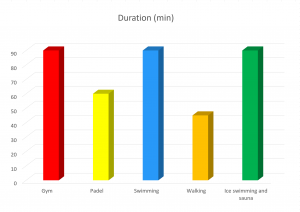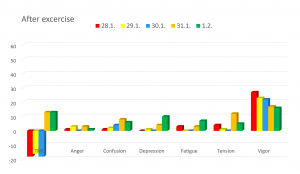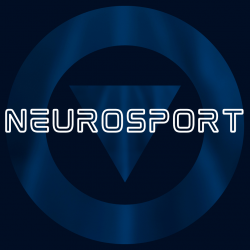Data collection
Due to misfunctioning of the Oura-ring borrowed from HU, HRV data was collected with FirstBeat device only. Unfortunately, the analysis of FearstBeat data was not possible to get in time, and therefore only mood state analysis and sleep quality analysis are introduced in this post. The sleeping diary from the Finnish Institute of Occupational Health was used to measure the quality and duration of sleep. Mood state data was collected with POMS (Profile of Mood States) test. For more information about the POMS testing, see the post.
POMS analysis
The data was collected during 28th of January to 2nd of February. The gym training was vigorous physical activity (MPA) exercise with heavy weights, moderate physical activity (MPA) in padel and walking, and swimming moderate to vigorous physical activity (MVPA) variating depending on the set. The last session of ice swimming and sauna was very light PA if at all, but I thought it would be interesting to see if there would be any effect on Total Mood Disturbance (TMD) or other subscales.

Figure 1.
As shown in the figure 2. and 3. there was significant decrease on TMD after each workout, especially after swimming, which reduced TMD by 52 scores, and anger, depression, fatigue and tension to round 0. Gym training and padel also reduced the scores of subscales and TMD significantly. Walking and ice swimming did not induce the scores as low as the other sports did, but TMD was higher to begin with. Like menitoned in the previous post, many studies have found the realtions between PA and positive POMS results, even after short amount of time of PA (Hansen et al., 2001).
In my case the positive effects were seen even after 40min walk, but most positive results were reached after MVPA or VPA. The lowest scores of TMD were after swimming and gym (-18). Swimming reduced also the scores of tension more than other sports. The score of vigor was moderately high each day before exercise, but increased after each session, including ice swimming and sauna.

Figure 2.

Figure 3.
In Lee & Shin (2020) study preferred physical activity decreased TMD significally, reduced stress symptoms and increased happiness among university students. There were not significant changes among the non-favored PA group. I do prefer swimming and gym over other sports, feeling joy and high self-competence. Padel instead felt a bit frustrating (still working on my technique), but still after game the scores of TMD reduced by 20.
It is remarkable that the score of TMD was a lot higher on weekdays than during weekend. The TMD scores decreased to minus during weekend and Monday, when walking and ice swimming on Tuesday and Wednesday did not reduce the scores to minus. The week I was having was very hectic, as you can see from the sleeping diary.
Compared to Beñat’s results, my TMD scores are much higher before exercise. Laura’s TMD scores were quite similar before exercise, but mine were much lower after. Unlike Beñat’s and Laura’s, my vigor scores were quite high to begin with, and got even higher after exercise. There are some individual differences, but still everyone’s results are very positive.
Sleep analysis
Unfortunately, due to misfunctioning of the Oura-ring, I did not get the data from sleep, but the sleeping diary can give some insight of the sleeping duration and quality. The sleeping diary was used from 27th January to 3rd February. The score of alertness was marked down when waking up and when starting and finishing work. Duration of the sleep during the testing period was 7-9 hours. Usually I prefer amount of 8,5-9 hours, which would be way over minimum recommendation by National Sleep Foundation (Hirshkowitz et al., 2015).
On Friday I consumed 3 doses of alcohol, and had some challenges to fall asleep, also woke up 6 times overnight. Even I slept 8,5 hours, I felt very tired in the morning and the score of alertness was 7. Like He et al. (2019) states, alcohol affects sleep negatively through multiple mechanisms, including triggering insomnia and shortening sleep duration. I slept less the next night, but score of alertness was 4 – perhaps the quality of sleep was better.
On Monday and Tuesday evening it took 1,5 hours before falling asleep, I was assuming due to stress I was experiencing during the beginning of the week. I was waking up 5 times during the night. Later I noticed that the amount of coffee I drank was highest (4 cups=400mg) during these two days, and half of the amount was drank late afternoon. The caffeine intake might have affected on the sleep; according to Drake et al. (2013) caffeine has disruptive effects on sleep if drank under 6 hours before bedtime.
As presented in the previous post, the effect of PA on sleep is still under debate. In this pilot test, PA had no clear association with sleep. I agree with Beñat that the sleep diary should be used for a longer period of time in order to have clearer results.
References
Drake, C., Roehrs, T., Shambroom, J., Roth, T. (2013) Caffeine effects on sleep taken 0, 3, or 6 hours before going to bed. J Clin Sleep Med 2013;9(11):1195-1200. https://doi.org/10.5664/jcsm.3170
Hansen, C. J., Stevens, L. C., & Coast, J. R. (2001). Exercise duration and mood state: How much is enough to feel better? Health Psychology, 20(4), 267–275. https://doi.org/10.1037/0278-6133.20.4.267
He, S., Hasler, B. & Chakravorty, S. (2019) Alcohol and sleep-related problems. Current Opinion in Psychology. Volume 30, 2019, p. 117-122. https://doi.org/10.1016/j.copsyc.2019.03.007
Hirshkowitz, M., Whiton, K., Albert, S. M., Alessi, C., Bruni, O., DonCarlos, L., Hazen, N., Herman, J., Adams, P. J., Katz, E. S., Kheirandish-Gozal, L., Neubauer, D. N., O’Donnell, A. E., Ohayon, M., Peever, J., Rawding, R., Sachdeva, R. C., Setters, B., Vitiello, M. V. & Ware, J. C. (2015). Natioanl Sleep Foundation’s updated sleep duration recommendations: final report. Sleep health, 1(4), 233-243. doi:10.1016/j.sleh.2015.10.004
Lee, H. W., & Shin, J. T. (2020). The effect of preferred physical activity on emotion, stress and happiness of university student. Research in Dance and Physical Activity, 4(3), 63-70. doi:10.26584/RDPE.2020.12.4.3.63
Sleep Diary By Finnish Institute of Occupational Health: https://www.ttl.fi/teemat/tyohyvinvointi-ja-tyokyky/elintavat/uni-ja-palautuminen

